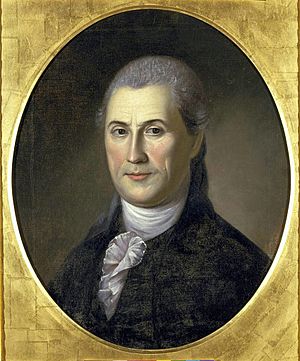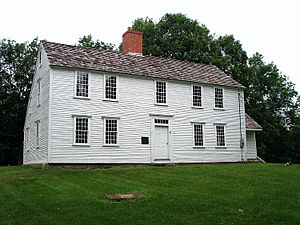Samuel Huntington (Connecticut politician) facts for kids
Quick facts for kids
Samuel Huntington
|
|
|---|---|
 |
|
| 18th Governor of Connecticut | |
| In office May 11, 1786 – January 5, 1796 |
|
| Lieutenant | Oliver Wolcott |
| Preceded by | Matthew Griswold |
| Succeeded by | Oliver Wolcott |
| 22nd Lieutenant Governor of Connecticut | |
| In office 1784–1786 |
|
| Governor | Matthew Griswold |
| Preceded by | Matthew Griswold |
| Succeeded by | Oliver Wolcott |
| 7th President of the Continental Congress | |
| In office September 28, 1779 – July 10, 1781 |
|
| Preceded by | John Jay |
| Succeeded by | Thomas McKean |
| Personal details | |
| Born | July 16, 1731 Windham, Connecticut, British America (now Scotland, Connecticut) |
| Died | January 5, 1796 (aged 64) Norwich, Connecticut, U.S. |
| Resting place | Old Norwichtown Cemetery, Norwich |
| Political party | Federalist |
| Spouse | Martha Devotion |
| Signature | |
Samuel Huntington (July 16, 1731 – January 5, 1796) was an important leader during the American Revolution. He was one of the Founding Fathers and a smart lawyer and politician from Connecticut.
He signed both the Declaration of Independence and the Articles of Confederation. He also served as the leader of the Continental Congress from 1779 to 1781. Later, he became the chief judge of the Connecticut Supreme Court. From 1786 until he died, he was the Governor of Connecticut. He was the first U.S. governor to die while still in office.
Contents
Early Life and Education

Samuel Huntington was born on July 16, 1731. His parents were Nathaniel and Mehetabel Huntington. He was born in Windham, Connecticut, which is now part of Scotland, Connecticut. He was the fourth of ten children and the oldest son.
Samuel had very little formal schooling. He mostly taught himself by reading books. When he was 16, he became an apprentice to a cooper, someone who makes barrels. He also helped his father on the family farm. He learned a lot by borrowing books from local lawyers and a minister named Rev. Ebenezer Devotion.
In 1754, Samuel became a lawyer. He moved to Norwich, Connecticut, to start his law practice. In 1761, he married Martha Devotion, who was Rev. Devotion's daughter. They were married until Martha died in 1794. They did not have their own children. However, they adopted their nephew and niece, Samuel "Jr." and Frances, after Samuel's brother died. Samuel Huntington never owned slaves.
Political Journey
Samuel Huntington started his political career in 1764. He was chosen to represent Norwich in the Connecticut Assembly. He served there until 1774. In 1775, he was elected to the Governor's Council, which was the upper house of the legislature. He stayed on the council until 1784.
He also became the king's attorney for Connecticut in 1768. This meant he was a lawyer who worked for the king. In 1773, he was appointed to the colony's highest court. He later became the chief judge of this court from 1784 to 1787.
Huntington strongly disagreed with the Intolerable Acts. These were strict laws passed by the British Parliament. Because of his strong views, he was chosen in 1775 to be a delegate to the Second Continental Congress. In January 1776, he joined Roger Sherman and Oliver Wolcott in Philadelphia. He voted for and signed the Declaration of Independence. He also signed the Articles of Confederation. He served in the Congress in 1776, from 1778 to 1781, and again in 1783.
Leading the Continental Congress
Samuel Huntington was not known for giving big speeches. But he was respected for his hard work and calm nature. Because of this, he was chosen to be the President of the Continental Congress. He took over from John Jay on September 28, 1779. This is why some people consider him an early "president."
The President of Congress did not have much power. It was mostly a formal role. But Huntington had to handle many letters and sign official papers. As president, he encouraged the states to provide soldiers, supplies, and money for the Revolutionary War. The Articles of Confederation were officially approved while he was president.
Huntington served as President of Congress until July 9, 1781. He had to resign because he was not feeling well. He returned to Connecticut. In 1782, Connecticut wanted him to be a delegate again. But his health and judge duties kept him from going. He did return to Congress in 1783. He was there to see the end of the war with the Treaty of Paris.
Governor of Connecticut
In 1785, Samuel Huntington built his large home in Norwich. In the same year, he was elected as the lieutenant governor of Connecticut. He served with Governor Matthew Griswold. In 1786, he became the Governor of Connecticut. He stopped being a chief judge when he became governor.
As governor, he helped solve land arguments between New York and Massachusetts. This led to the Treaty of Hartford in 1786. In 1787, he supported the Northwest Ordinance. This law helped organize new territories in the west. In 1788, he led the Connecticut meeting that approved the United States Constitution. Later, he helped Connecticut become a U.S. state. He also helped decide that Hartford would be the permanent state capital. He oversaw the building of the state house there.
Later Life and Legacy
Samuel Huntington died in his home in Norwich on January 5, 1796. He was still serving as governor when he passed away. His tomb is in the Old Norwichtown Cemetery. It was restored in 2003.
Several places were named in his honor. Huntington, Connecticut was named after him in 1789. It is now called Shelton. Huntington County, Indiana and Huntington Mills, Pennsylvania are also named for him.
The house where Samuel Huntington was born was built by his father around 1732. It is still standing today in Scotland, Connecticut. In 1994, a group bought the home to protect its history. The Samuel Huntington Birthplace is a very important historic site.
His nephew and adopted son, Samuel H. Huntington, moved to Ohio. He later became the third governor of Ohio.
Some people in Connecticut believe Samuel Huntington was the first President of the United States. This is because he was the president of the Continental Congress when the Articles of Confederation were approved.
Images for kids
See also
- Memorial to the 56 Signers of the Declaration of Independence
- Huntington family


